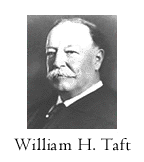|
The
Philippine-American War
 On
February 4, 1899, an American soldier, Private William
Grayson, shot a Filipino soldier at the bridge of San
Juan, Manila. The fatal shot was followed by an immediate
U.S. offensive on the Filipino lines. This marked the
beginning of the Philippine-American War, which lasted
for three years until the establishment of the civilian
colonial government of Governor-General William Howard
Taft on July 4, 1902. The timing of the San Juan incident
is suspect since it happened only two days before the
U.S. Congress was scheduled to ratify the Treaty
of Paris on February 6, 1899. Under the treaty,
Spain officially ceded the Philippines, Guam, and Puerto
Rico to the United States in exchange for $20 million.
Since the U.S. Congress, like the American public, was
evenly split between the anti-imperialists and pro-annexationists,
the treaty was expected to experience rough sailing
when submitted to the Chamber for ratification. The
San Juan incident and the outbreak of the Philippine
American War tilted sentiment in favor of acquiring
the Philippines, and thus the treaty was ratified by
the U.S. Congress. On
February 4, 1899, an American soldier, Private William
Grayson, shot a Filipino soldier at the bridge of San
Juan, Manila. The fatal shot was followed by an immediate
U.S. offensive on the Filipino lines. This marked the
beginning of the Philippine-American War, which lasted
for three years until the establishment of the civilian
colonial government of Governor-General William Howard
Taft on July 4, 1902. The timing of the San Juan incident
is suspect since it happened only two days before the
U.S. Congress was scheduled to ratify the Treaty
of Paris on February 6, 1899. Under the treaty,
Spain officially ceded the Philippines, Guam, and Puerto
Rico to the United States in exchange for $20 million.
Since the U.S. Congress, like the American public, was
evenly split between the anti-imperialists and pro-annexationists,
the treaty was expected to experience rough sailing
when submitted to the Chamber for ratification. The
San Juan incident and the outbreak of the Philippine
American War tilted sentiment in favor of acquiring
the Philippines, and thus the treaty was ratified by
the U.S. Congress.
|

